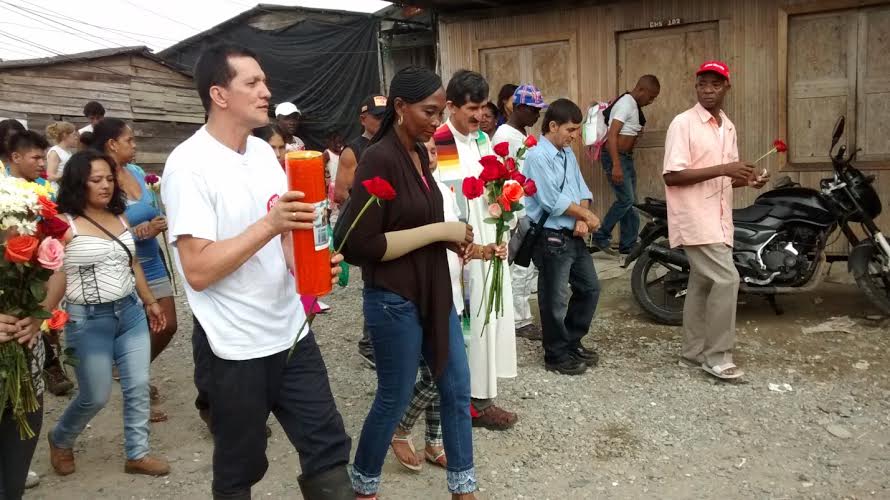
On April 13, 2014, an Afro-Colombian community of approximately 300 families known as Puente Nayero did something unprecedented in Colombia’s largest port city of Buenaventura: they formed an urban Humanitarian Space. Criticizing the collusion of state security forces with paramilitaries, community members rejected the militarization of their oceanfront neighborhood and began resisting multinational companies trying to displace them from their homes.
On April 13, 2014, an Afro-Colombian community of approximately 300 families known as Puente Nayero did something unprecedented in Colombia’s largest port city of Buenaventura: they formed an urban Humanitarian Space. Criticizing the collusion of state security forces with paramilitaries, community members rejected the militarization of their oceanfront neighborhood and began resisting multinational companies trying to displace them from their homes.
This April, the Puente Nayero Humanitarian Space celebrated one year of nonviolent resistance and organizing, taking time to look back on the past year’s achievements. Despite receiving constant death threats over the last year, Puente Nayero formed a leadership committee, petitioned for accompaniment from the Interchurch Commission for Justice and Peace (a Colombian NGO that documents and defends human rights) and joined the network of 120 communities known as Communities Building Peace in the Territories (CONPAZ) to organize and defend their territorial, cultural, and human rights. Committing to a practice of nonviolence, they succeeded in removing paramilitary presence from their street, dismantling a chop-up house that had been installed to dismember and terrorize people, and strengthening community support of the process.
However, according to community leaders, commemorating the Humanitarian Space involves much more than celebrating the accomplishments of the past year. In response to the recent assassination of merchant Wilder Giraldo Salazar – murdered for refusing to pay extortion taxes to paramilitaries – the Puente Nayero community used the one-year commemoration intentionally to strengthen their relationship with neighboring community Punta Icaco. Taking back Punta Icaco from paramilitary control has been no easy task, however, and various community members such as Joaquín Giraldo and his wife Rubiela Berrio have already received threats for supporting the nonviolent initiative by inviting national and international accompaniers into their neighborhood.
Displacement for development
The commemoration is furthermore a strategic moment to strengthen the community’s organizational process and, in particular, to solidify resistance to the mega-projects being planned and implemented in Buenaventura today. For Puente Nayero, paramilitary presence indicates a larger, more insidious phenomenon: the use of such violent non-state actors to effect mass displacements in Buenaventura, freeing up land for multinational corporations in the name of “development,” a proposal tacitly supported by the Colombian state. Various cases of links between paramilitaries and multinational actors have been documented extensively in Colombia, with well-known examples involving companies such as Chiquita Brands International, Coca-Cola, and Nestle.
“What displaces us?” asked community leader Orlando Castillo. “Capital. Capital is displacing us from our territories, capital that comes from big cities in Europe, Asia, and the United States. It’s foreign investment that’s killing us in our communities.”
As the Colombian government continues to implement neoliberal economic policies, signing on to agreements such as the U.S.-Colombia Free Trade Agreement, the Pacific Alliance regional free trade bloc, and the Colombia-Canada Free Trade Agreement, communities have noticed increased presence of armed actors in strategic territories for foreign investment.
Buenaventura in particular has been a key area for international investment and development projects as the port moves more than 600,000 containers each year, representing approximately 60 percent of Colombia’s imports and exports. This benefits almost exclusively the estimated 12 owners of Buenaventura’s port business, further increasing inequality in a city of over 300,000 inhabitants with a 90 percent poverty rate.
In the case of Puente Nayero, located in the La Playita neighborhood, the implementation of an oceanfront boardwalk tourist project has been most directly responsible for displacement.
“It is the Bahía de la Cruz Boardwalk [project] that wants to kick us out, to exterminate the communities that are here, mostly in the oceanfront neighborhoods,” affirmed spokeswoman Nhora Isabel Castillo. She further added that the proposed relocation for the families of La Playita to the inland neighborhood of San Antonio will result in a “complete extermination of our community” culturally and economically, as the relocation community has no access to the ocean and 60 percent of the Afro-Colombian families in Puente Nayero have ancestrally maintained themselves through small-scale fishing.
Puente Nayero’s experience with the Bahía de la Cruz Boardwalk project is only one example of international investment in Buenaventura, providing a glimpse into how development projects displace vulnerable communities in Colombia. A dozen other megaprojects in the area including various port expansion projects seek to make Buenaventura a place for business, not a home for people, according to a presentation in the Colombian Senate in September 2014.
One indigenous community member visiting the Humanitarian Space during the first anniversary holds the Colombian government directly responsible for violence: “The government is the first to violate people’s human rights; they’re the first to beat down and oppress the people.” In his perspective, foreign investment in Colombia has largely served to displace vulnerable communities – mostly Afro-Colombians, indigenous people, and small-scale farmers – to promote development projects that further feed the rich and worsen inequality.
In such a complex situation, the Humanitarian Space is a small symbol of hope for the people of Buenaventura. By slowly expanding their nonviolent space and organizing with other communities throughout Colombia to resist physical and economic violence, the people of Puente Nayero work for more inclusive and sustainable peace-building processes. Celebrating one-year of resistance, children and youths gather together to sing, their anthem echoing throughout the neighborhood:
“Today, the Humanitarian Space of Puente Nayero is an example for the whole world
So the government takes notice that we support nonviolence
We are a people who want freedom so there can be peace with justice and dignity
We are a people who want freedom so there can be peace with justice and dignity.”
Lisa Taylor is a member of the Witness for Peace Colombia Team.
